This Thursday, our country will release the latest trade data, and whether exports will continue to decline negatively has become a focal point of concern for many.
In the data from the previous month, our country's exports fell by 14.5% year-on-year, marking the largest decline since March 2020.
The last time the decline exceeded 14.5% was in February 2020, when the COVID-19 pandemic was in full swing, Wuhan was locked down, and the year-on-year decline reached 40.6%.
However, the situation is now vastly different from three years ago. The pandemic has passed, and the economy is recovering. The significant decline in exports is not only surprising but also worrying.
01
Since our country joined the WTO, trade has developed rapidly over the past 20 years, and a large amount of exports have also created a large amount of foreign exchange reserves. But recently, exports have suddenly stopped growing, which is a difficulty we have not encountered before.
The main influencing factor in the past two years was still the pandemic, but it would be unreasonable to blame the pandemic for the current situation.
Many people have noticed that in recent years, many foreign companies have transferred manufacturing orders to Southeast Asia or Mexico and Canada.
Advertisement
Now, even more domestic companies are transferring manufacturing orders to Vietnam, Thailand, and Indonesia due to cost considerations.
It can be seen that the export difficulties we are facing are likely not short-term.However, the reasons for the decrease in exports are worth our deep reflection and should not be simply attributed to the outsourcing of manufacturing.
The broader environmental reason lies in the continuous interest rate hikes by the United States, leading to a contraction in demand in European and American countries.
Recently, Vietnam's exports to the United States have also decreased by 19%, and other Asian manufacturing export-oriented countries have seen varying degrees of decline, indicating that the problem is not solely with us.
Not only has the United States experienced a significant contraction in imports, but the European Union has seen the same.
In the first half of this year, the total import volume of the European Union decreased by 10% year-on-year. This is not just about bilateral trade data with China, but rather a decrease in the total volume of goods imported by the European Union from all other economies.
From this, it can be seen that both the United States and other Western developed countries like Europe are now facing serious issues with budgeting and demand contraction.
03
At the same time, we should not overly focus on Chinese companies transferring manufacturing orders overseas. Although this reduces our exports, it does not reduce profits.
We can first take a look at the example of Japanese automobiles.This year, Japan's automobile exports may fall below those of our country, relinquishing the top spot. This is certainly due to the continuous progress made by our nation, but another reason should not be overlooked: Japanese automakers have established numerous factories overseas, producing and selling directly from local sites. These, of course, do not count as Japanese exports.
However, we must not assume that Japan is not making money just because these automakers have set up factories abroad. They are simply producing and selling in a different location, and the money is still being earned.
By the same token, many Chinese companies, in order to gain a more advantageous position in manufacturing costs, have also begun to shift their manufacturing orders to Southeast Asia, where costs are lower and thus more competitive. The money that should be earned is still being earned; it's just no longer counted as Chinese exports.

A significant part of the reason for the decrease in our exports lies here, and this transformation process is normal for any country that is gradually becoming stronger.
We should also pay attention to the fact that our country's high-end manufacturing has developed. Exporting 10,000 shirts may not be as valuable as exporting a single new energy vehicle. This is the direction of our future development: to transfer low-end manufacturing and focus on developing high-end manufacturing. Even if one day, like the United States, our export volume falls below our import volume, resulting in a trade deficit, it would not be a problem as long as the proportion of high value-added exports is sufficiently high.
If one day we are exporting a large number of new energy vehicles, high-speed trains, and even satellites, even if we import more bags and shoes, and the surplus turns into a deficit, we will only be making more money, and the basic consumer goods we enjoy will only become cheaper.
The current decline in exports may be a challenge that we have not encountered in the past 20 years, but it is clear that our strategic layout is gradually showing results.